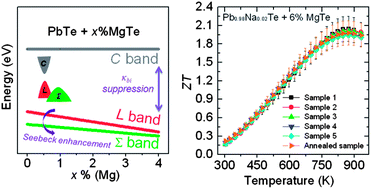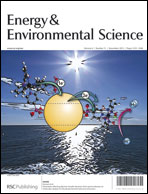All-scale hierarchical thermoelectrics: MgTe in PbTe facilitates valence band convergence and suppresses bipolar thermal transport for high performance†
Abstract
We report a high ZT of ∼2.0 at 823 K for 2% Na-doped PbTe with 6% MgTe with excellent thermal stability. We attribute the high thermoelectric performance to a synergistic combination of enhanced power factor, reduction of the lattice thermal conductivity and simultaneous suppression of bipolar thermal conductivity. MgTe inclusion in PbTe owns triple functions: the Mg alloying within the solubility limit in PbTe modifies the valence band structure by pushing the two valence bands (L and Σ bands) closer in energy, thereby facilitating charge carrier injection. When the solubility limit of Mg is exceeded, ubiquitous endotaxial nanostructures form, which when coupled with mesoscale microstructuring results in a very low (lattice) thermal conductivity through all-scaled length phonon scattering. Meanwhile, most significantly, the Mg alloying enlarges the energy gap of conduction band (C band) and light valence band (L band), thereby suppresses the bipolar thermal conductivity through an increase in band gap.


 Please wait while we load your content...
Please wait while we load your content...